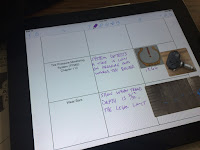The Power of Learning Objectives
As Mr. +Paul Fraser explained in last week’s blog post, he uses learning objectives on a regular basis with his Physics students in order for them to better understand their own learning and for him to plan his instruction and receive valuable assessment data to better inform his future lessons. These learning objectives are used systematically in class by both Mr. Fraser and the students.
Awesome. Now what?
At some point in our formal education and/or teaching experience, we learned about writing effective, measurable learning objectives...but a refresher couldn’t hurt, right?
The difficult part of this topic (other than the actual work involved writing the objectives) is the terminology. Do a simple Google search of “learning objectives” and a plethora of sources debating the use of terms fill the screen. In some of the current educational literature, the terms “learning objectives” and “learning targets” are interchangeable. Likewise, many sources use the terms “learning standards”, “learning goals, and “learning outcomes” to communicate the same idea. While some argue that there are significant differences between all of these terms, for the sake of this blog post, the terms “learning objectives” and “learning standards” will be used.
To begin, it is valuable to differentiate between the idea of learning objectives and learning standards. Learning standards can be thought of as the big picture questions your students seek to answer by the end of the course, while as learning objectives are specific, task-oriented statements that allow the students to understand exactly what the end product is that you have in mind and the steps they take to get there. As stated by Goodwin (2009), “A standard answers the question, ‘Where am I going in my learning?’ while learning targets [objectives] show students the path to get there.”
In order to effectively use learning objectives, the first, and probably most daunting, step is writing them. The whens and hows depend on your courses. For some singleton classes, this may be something that can be done on your own schedule as you are the sole decision maker. For others with classes that relate to outside areas, the objectives may already exist and just need some modification along the way. And for some, it is a matter of finding common time to work on them (e.g. for the Spanish PLTs this means applying for summer workshop hours).
When writing learning objectives for a class, it is helpful to refer to sources that give us a structure and examples for writing them as seen in this image.
Much of the current educational literature ties objective writing into Bloom’s Revised Taxonomy. The general idea is to give students specific, achievable objectives that they will work toward in a lesson or other specified time frame. For example, a learning objective for those reading this blog post might be, “By the end of this blog post, I will be able to generate course-specific objectives for my students.”
If you are wondering why you are reading about this topic on our Ed Tech blog, you probably aren’t alone. With the continued implementation of more technology in our classrooms, it is important that good teaching be the lead of our discussion. We, as teachers, know that writing effective, measurable objectives makes sense and can help our students on many levels. The connection to technology is that once we have written these learning standards and objectives for our courses, the next step is implementing them into our classrooms every day on a formative and summative level leveraging technology to help us make these learning objectives pertinent to the students and a regular part of our classrooms.
This blog post is part of a series on the fusion of technology and learning objectives. Future posts will include the students using these learning objectives on a regular basis for and the integration of technology to do so.
Co-authored by:
Ms. +Dawn Bodden (Innovative Technology Facilitator) &
Ms. +Ann Syversen Bullis (Division Technology Coach)


Comments
Post a Comment